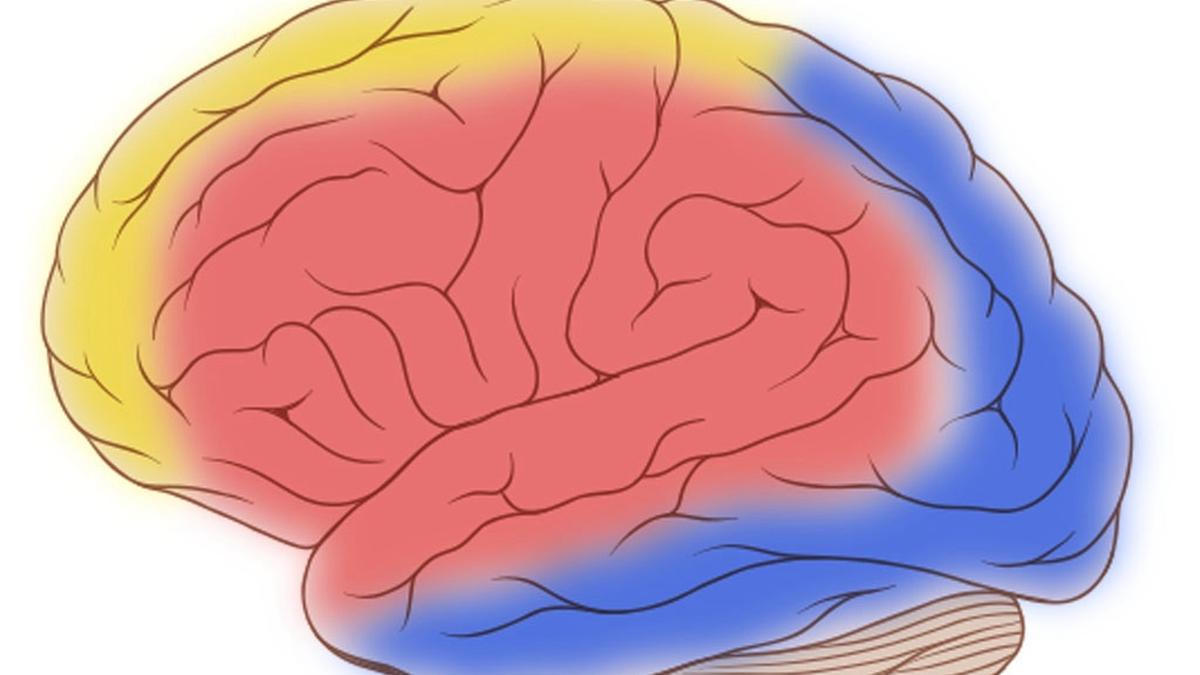The anterior, middle, and posterior cerebral arteries respectively supply the yellow, red, and blue parts of the brain.
| Photo Credit: Frank Gaillard, Patrick J. Lynch
The brain is a guzzler, burning through about a fifth of our resting energy and keeping almost nothing in reserve. When a few thousand neurons suddenly burst into activity — e.g. when you spot a familiar face in the crowd — the fuel has to arrive immediately. Blood vessels open wide to let it in but they can’t rob neighbouring regions to pay for the rush. The whole supply network must pitch in, and here lies the mystery: even the most distant arteries seem to respond almost instantly.
Scientists call this process neurovascular coupling. Neurons fire, nearby capillaries widen, and blood flow rises as arteries join in, pushing more fuel into the pipeline. Researchers have seen messages travelling ‘upstream’ from smaller vessels to bigger ones but the known chemical messengers moved too slowly to explain the brain’s split-second feats. Something else was clearly at work that passed the call to action almost instantaneously.
Cells lining the brain’s blood vessels are linked by gap junctions, narrow portals that let neighbouring cells exchange ions and small molecules. When Chengua Gu’s lab at Harvard University introduced serotonin into one cell, it slipped through the junctions to its neighbours. A later test revealed a web of connections that were strongest in the arteries and weaker in the veins. The team found that two connexin proteins, Cx37 and Cx40, were especially abundant in the arteries and inferred they may be responsible for the rapid call to action.
The findings were published in Cell in July.
University College London neuroscientist David Attwell said this arrangement lets signals travel along vessel walls to widen upstream arteries, boosting blood flow to active brain areas. Brant Isakson, a vascular physiologist at the University of Virginia, added that different vessels use different connexins to pass certain signals better, “like specific pipes for specific fluids”.
To prove the link, the Harvard team bred mice that lacked Cx37 and Cx40 in their artery walls. In healthy mice, a burst of brain activity sent a widening signal along the arteries that reached more than a millimetre in a quarter of a second. In the modified mice, the signal moved at a third of the speed.
The gap became most obvious when large swaths of the brain lit up. In healthy mice, the widening action spread rapidly and in sync across the arterial network. In the modified mice, it was slower, weaker, and stuck near the source. The results suggested that gap junctions acted as a “scaling mechanism” that let blood delivery grow to match bursts of brain activity.
Anna Devor, a neuroscientist at Boston University who studies how blood flow shapes fMRI signals, said the study nailed down the mechanism that lets vessel-widening signals travel along the vessel walls and measured how fast that happens.
“Knowing both the mechanism and the speed is priceless for computer models linking brain activity to blood flow,” she said. Such models, according to her, could help detect vascular problems, test drugs virtually, and guide therapies, especially when paired with artificial intelligence models.
The results could also help explain mismatches between brain activity and blood flow. Devor recalled the late imaging pioneer Amiram Grinvald likening the brain’s oxygen supply to “watering the entire garden for one thirsty flower”. Signals to widen vessels often travel upstream, adding delays: hundreds of milliseconds in small arteries and over a second in larger ones. This study shows that gap junctions account for much of that lag, with the rest due to slower chemical messengers reaching their target vessels.
The work may also raise questions about disease. Attwell noted that it’s possible, but unproven, that losing gap junction connections in aging or small vessel diseases could lower brain blood flow. Testing that idea, he said, would mean boosting the proteins in lab animals and seeing if that improved brain function.
According to Isakson, the findings could help develop drugs to activate connexins as well as discover how the brain’s 20-plus connexin protein types combine into mosaic junctions that fine-tune messages from cell to cell.
The brain’s energy efficiency depends on more than just responsive neurons: it requires a hidden vascular network. Here, the arteries exchange rapid messages through the gap junctions, coordinating supply lines across millimetres in the blink of an eye. This chatter is a reminder that the brain’s lifeblood is as much in its wiring as in its firing.
Anirban Mukhopadhyay is a geneticist by training and science communicator from Delhi.
Published – August 17, 2025 05:30 am IST
